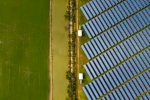
The infrastructure sector sits at a collision point of global disruptions, including shifts in capital availability, evolving social and environmental priorities, and rapid urbanisation. However, the emergence of COVID-19 introduces an altogether new set of challenges. The full impact of the pandemic will take years to play out. Yet in the near term, we believe it will affect governments’ ability to finance large-scale projects. Most countries faced a gap between infrastructure needs and financial resources before the pandemic hit; that gap is now larger as a result of it. Successful infrastructure delivery demands close alignment and collaboration between a wide range of participants, each with its own agenda and interest. The result? No single player acting alone can effect real change in the sector.
This is the second article in a four-part series examining the overarching forces that will shape the future of the infrastructure industry. The first looked at the immediate impact of COVID-19. Subsequent pieces will consider:
The impact of technology.
Technology is disrupting the way infrastructure is used and the way capital projects are delivered. New and emerging technologies will be a big part of the solution to the world’s infrastructure challenges. But accelerating the pace of technological progress and innovation on infrastructure projects will require a step change in policy focus, new financing solutions and business models, and more research and development.
The need for resilience and sustainability.
Although the world’s attention has most recently been focussed on the COVID-19 global health crisis, the impacts of climate change and urbanisation continue to mount and still pose significant challenges, to which governments and the infrastructure community will need to respond.
The infrastructure funding challenge
The pressing global need for substantial infrastructure is widely recognised. For populations worldwide, upgraded or new infrastructure will be pivotal to the future availability of clean drinking water, housing and business space, lighting, sanitation, and other vital resources. As a result, the total global requirement for infrastructure investment is estimated at US$3.9tn annually,[1] with the greatest demands being in emerging markets.
Urbanisation, population growth and economic expansion — forces that are particularly powerful in developing countries — are making the need for new and updated infrastructure even more urgent. The urban population is expected to grow from 3.9bn today to around 6.3bn by 2050. The Asian Development Bank (ADB) estimates that some US$1.7tn will have to be invested annually in infrastructure across Asia through 2030 if the region is to maintain its growth momentum, eradicate poverty and respond effectively to climate change.[2] This is more than double the US$750bn annual requirement announced in 2009. The gap between infrastructure capital demand and supply is not narrowing — it is widening.
Such investments are not optional: infrastructure is critical not only for meeting basic human needs, but also for supporting economic growth and maintaining quality of life. In 2018, the number of people living in informal settlements — which lack basic resources such as clean drinking water, sanitation and lighting 3/4 rose to more than 1bn. Over 80% of affected people are located in three regions: Southeast Asia, sub-Saharan Africa, and Central and Southern Asia, according to the United Nations (UN).[3] The total global population of informal settlements is expected to reach a staggering 2bn by 2030 — meaning that about 25% of the projected global population will be without the infrastructure to meet their most basic requirements.[4] These figures underline the scale of the challenge.
The challenge isn’t just to fund the massive investment required and target it at the right infrastructure projects. It’s also necessary to provide the required infrastructure on an affordable, socially equitable and environmentally sustainable basis, and against the backdrop of climate change. These issues were formidable even before COVID-19 emerged. But the pandemic — and the pressure it will exert on the global economy — take the infrastructure finance and funding challenge into uncharted territory.
Why is there a gap between infrastructure capital demand and supply?
Although the terms funding and financing are often used interchangeably, they mean very different things. Understanding this difference is an important part of analysing and communicating the challenges to closing the infrastructure gap.
Financing represents the money borrowed and has the effect of time-shifting costs incurred. For example, a city borrows money to construct an infrastructure project and doesn’t start to repay the loan for five years. In this case, the cost of the project has been time-shifted into the future through financing. However, financing doesn’t set out how the funds to repay the loan will be earned.
Funding is the means by which a project’s costs are repaid, regardless of the period to which these costs are time-shifted. For infrastructure, this generally means identifying the long-term revenue stream necessary to repay the money initially invested, plus interest.
In light of the distinction between financing and funding, how do costs fit in? For the foreseeable future, governments will remain the largest payers, generating revenue for infrastructure costs through taxes, tolls and other user charges. Although users and customers will inevitably pay in the future to benefit from the services that infrastructure enables, governments will ultimately continue to fund and underwrite it. This makes closing the gap in less developed countries especially difficult, because their governments and citizens generally have fewer resources to contribute to infrastructure than do their more developed counterparts.
Some money is available in the form of grants, concessional loans and the like, but in terms of getting infrastructure development underway, governments cannot finance the needs alone. So multilateral development banks (MDBs), international financial institutions (IFIs) and other sources of private finance will all continue to play an important role.
It is important, however, not to think of MDBs and IFIs as playing a substantial gap-filling role. Their direct finance, even if stretched, is dwarfed by the estimated infrastructure gap.[5] It is more important to focus on how their resources can be used to draw in more resources. In developing economies in particular, MDBs are actively seeking to tap into private capital through mechanisms such as blended finance.[6] This financing model seeks to remove bottlenecks by reducing risks and guaranteeing investments via instruments such as guarantees or flexible (concessional) debt or equity. MDBs can also provide support by improving the local investment climate and offering specialised advisory services or local expertise to bridge knowledge gaps on transactions. Blended finance isn’t intended to unnecessarily subsidise private investors. It is implemented by MDBs and IFIs in specific circumstances to encourage investment by facilitating risk-taking to an acceptable level.
Yet despite these ongoing efforts, not enough of the potential investment is finding its way to developing countries. The World Bank indicates that pension funds, sovereign wealth funds, mutual funds and other institutional investors make up only 0.67% of total global investment in developing countries.
This low investment level is predominantly due to perceived risks around political instability, currency fluctuations, the degree to which earnings can be repatriated, rule of law and the ability of users to pay required tariffs. (For more insights into private sector infrastructure investment, see Increasing private sector investment into sustainable city infrastructure.)
Furthermore, the volume of investment in projects early in their life cycles isn’t enough to support the development of new infrastructure — especially when costs are often quoted in the trillions of dollars. Many greenfield opportunities arise in emerging markets, adding another perceived risk dimension. All of these factors help to explain why the gap between capital demand and supply isn’t closing, and is even more pronounced in the initial stages of the life cycle of projects.
Various governments, donors and institutions have sought to help narrow the gap by providing funding for project preparation facilities (PPFs) — platforms that support activities early in a project’s life cycle — and upstream support to create opportunities for project development and investment.
In general, private capital is reluctant to invest at the required scale in large greenfield developments, given the difficulties both in accurately budgeting development costs and timelines and also in forecasting future revenues in the absence of an operating history. These concerns are heightened by well-publicised examples of greenfield construction projects experiencing difficulties. For example, construction of the metro system in Salvador, Brazil, began in 2000, but it took more than a dozen years for the first passengers to ride it.
The aversion to early-stage projects in developing countries — despite the growing need for infrastructure investment in those areas — has resulted in a pool of inaccessible capital building up, as private investors grapple to target a limited group of assets perceived to be safer. At the same time, banks continue to face pressures on long-term lending, causing them to lend over shorter terms or for larger lump-sum repayments.
However, the growing involvement of institutional investors has been a positive development. The period since the 2008 global financial crisis has seen a significant increase in institutional lenders such as pension funds and insurance companies putting debt and equity into infrastructure projects. In some cases, they have provided debt to enable operational infrastructure projects to refinance and/or take out bank lending; increasingly, they have also shown remarkable flexibility in lending to projects entering or already in the construction phase. These institutional investors are logical holders of infrastructure debt, because it matches with their long-term liabilities.
Other forces shaping the landscape
A further vital factor helping to shape the financing landscape is the global shift from a ‘brown’ to a ‘green’ economy. The UN’s Sustainable Development Goals (SDGs) are supporting this transition, and infrastructure appears both as an explicit goal and as an implicit means to implement and achieve other SDGs. The financial costs of meeting the SDGs have been estimated at US$5tn to US$7tn annually through 2030, with about half going to developing economies.
An expanding base of stakeholders — including investors and civil society generally — are now looking to develop and benefit from more energy-efficient and environmentally sustainable built assets. This demand is coupled with a rise in activists targeting companies and high-profile individuals linked to the fossil fuel industries and others generating substantial carbon emissions.
These developments are driving pools of capital to be directed to those investments with a positive impact profile, with environmental, social and governance (ESG) considerations becoming more embedded in the risk assessment, selection, management and reporting processes for a growing proportion of investors, in both infrastructure and other assets. According to the latest biennial Global Sustainable Investment Review from the Global Sustainable Investment Alliance (GSIA), released in mid-2019, global sustainable, responsible and impact (SRI) investments stood at US$30.7tn at the start of 2018, a rise of 34% from 2016.[7] Europe accounted for the largest pool, with US$14.1tn of SRI assets under management, followed by the US, with US$12tn. Furthermore, the Climate Bonds Initiative has estimated that the total issuance of green bonds — debt instruments designed to raise capital specifically for environmentally friendly projects — hit US$250bn in 2019, up from US$3.5bn in 2012.[8]
The shift in public opinion and market sentiment towards sustainable assets is also driving corporations, banks and other investors to assess their existing portfolios and assets that threaten to add to global warming. According to the Financial Times, around US$900bn — one-third of the current value of big oil and gas companies — would disappear if governments more aggressively restricted activities leading to the rise in global temperatures.[9] Stranded-asset risk will be an increasing focus going forwards.
As ESG and climate-related standards and frameworks continue to gain ground, there will theoretically be no shortage of financing for sustainable infrastructure. However, scaling this investment up will continue to require government intervention to make the business models work and attract investment, whether through subsidies, tax breaks or other mechanisms. These measures will have to be supported by a step change in public policy and private investment decisions to make climate resilience an automatic and critical investment consideration.
Moreover, new technologies will be a big part of the solution to today’s infrastructure challenges, improving transparency and efficiency while also creating new, often more sustainable, business models — from design through to operation and decommissioning. Indeed, new technologies are already generating new businesses and with them new opportunities, challenges, cash flows and services for governments. For example, some municipal streetlights are now being fitted with sensors, wireless transmitters, electric vehicle charging stations, 5G transmitters and other digital technologies.
However, as with every other industry it touches, technology will be a disruptive force for infrastructure. Ever-shorter technology lifespans sit uncomfortably in long-term, inflexible infrastructure contracts. And as the adoption of new technology increases, investors will feel more comfortable about projects that leverage it for the public good. This suggests that shorter-term, more flexible contracts and financing will be required — both to respond to the changes in expectations and demand, and also to take advantage of the opportunities that technology opens up.
A new financing model to build a new world
What can be done today to meet tomorrow’s need for infrastructure financing? In simple terms, we need to help direct more private finance into infrastructure, particularly in emerging markets. We need to better prepare projects. And we need to de-risk investments, using a range of financing mechanisms.
Especially when projects are in the pre-construction phase, the most effective way to attract private capital may be to increase the emphasis on mechanisms such as blended finance,[10] thereby attracting outcome-focussed and multilateral and philanthropic sources of development capital and/or funding. The issue boils down to the allocation of risk among different stakeholders, including taxpayers, users, financiers, insurers and the like. If these various stakeholders are all involved in a project, allocating risk among them will require clarifying the related complexities and getting each party’s objectives — for example, focussed more on development or commercial returns — properly aligned.
This latter point was demonstrated recently as measures to contain the COVID-19 pandemic were enforced. Projects financed as public–private partnerships (PPPs) with demand-based contracts — such as airports and toll roads — suffered dramatic drops in passenger volumes, proving them to be vulnerable to external shocks. It is too early to know the long-term impact of COVID-19, but the crisis is likely to prompt a reassessment of investment risk and a shift to more conservative PPP deal structures that mitigate some of the potential risk from macro-economic conditions (for example, risk-sharing components and guarantees). The crisis also raises longer-term questions about the business models for those assets most severely hit, such as airports.
MDBs and IFIs are already playing an important role in encouraging more private investment, particularly for emerging economies. Building on that progress will require well-established support around the enabling environment — both for the general investment climate and in specific infrastructure sectors — as well as the use of initiatives such as project preparation facilities.
Looking across the current global environment for infrastructure financing, it’s clear that the biggest challenge isn’t the availability of funds. Instead, the challenge lies in mobilising those funds more effectively: building a pipeline of feasible projects and creating the structures, incentives and confidence level needed to convince private capital to invest.
The MDBs alone don’t have the balance sheets to be the risk takers of last resort in the volumes needed to close the gap. Ultimately, governments and taxpayers in the countries in which the projects are being built are going to bear this burden. Given affordability constraints, particularly in emerging markets, there is a strong possibility the gap will never close. In that case, the aspiration should be to close it as much as possible.
However, as the sheer diversity of forces and pressures underlines, money alone won’t solve the problem. To narrow the gap between funding availability and need — between the risk appetite of investors and the places where investment is most urgently required — we’ll need governments, MDBs and investors to continue to work together and develop innovative ways to finance infrastructure.
In the next article in this series, we focus on another important global force shaping infrastructure: sustainability.
References
[1] European International Contractors, Global Infrastructure Outlook to 2040, 17 Nov. 2017: https://www.eic-federation.eu/industry/global-infrastructure-outlook-2040.
[2] Asian Development Bank, Meeting Asia’s Infrastructure Needs, 2017: https://www.adb.org/sites/default/files/publication/227496/special-report-infrastructure.pdf.
[3] United Nations Department of Economic and Social Affairs, The Sustainable Development Goals Report, “Goal 11: Sustainable Cities and Communities,” 2019: https://unstats.un.org/sdgs/report/2019/goal-11.
[4] Ibid., and Inter-American Development Bank, “Investing in Safe Sanitation in Informal Settings,” 12 Nov. 2019: https://blogs.iadb.org/agua/en/investing-in-safe-sanitation-in-informal-settlements.
[5] World Wide Web Foundation, Closing the Investment Gap: How Multilateral Development Banks Can Contribute to Digital Inclusion, 23 Apr. 2018: https://webfoundation.org/research/closing-the-investment-gap-how-multilateral-development-banks-can-contribute-to-digital-inclusion.
The World Wide Web Foundation estimates that MDB commitments to infrastructure development projects now average around US$100bn to US$120bn annually, financing 1,100 to 1,400 projects every year.
[6] The Organisation for Economic Co-operation and Development defines blended finance as “the use of development finance and philanthropic resources to mobilise private capital at scale so as to deliver risk-adjusted returns and economic progress across a range of sectors and countries while ensuring significant development outcomes.”
[7] Global Sustainable Investment Alliance, Global Sustainable Investment Review 2018: https://moxiefuture.com/2019/06/global-sustainable-investment-review-2018-reports-sri-assets-globally-surpass-30-trillion.
[8] Climate Bonds Initiative, Green Bonds: The State of the Market 2018, Dec. 2018: https://www.climatebonds.net/resources/reports/green-bonds-state-market-2018.
[9] Alan Livsey, “Lex in depth: the $900bn cost of ‘stranded energy assets,” Financial Times, 4 Feb. 2020: https://www.ft.com/content/95efca74-4299-11ea-a43a-c4b328d9061c.
[10] Ben Payton, “Blended Finance: A Model for Impact Investors?” Private Equity International, 13 Feb. 2020: https://www.privateequityinternational.com/blended-finance-a-model-for-impact-investors. (Article access requires registration.)
Convergence is a Canadian organisation that collects data on blended finance transactions. Its latest annual report shows a steady growth trend in blended finance activities (across commercial investors, private equity firms, venture capital firms, institutional investors and banks), with capital commitments of about US$20bn annually. Banks accounted for 46% of those commitments to blended finance transactions between 2016 and 2018.
Contact us

Global Capital Projects and Infrastructure Leader, PwC United Kingdom
Tel: +44 7764 235 239



















